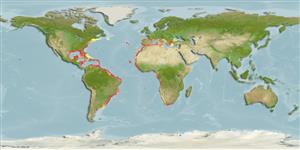Common names from other countries
>
Eupercaria/misc (Various families in series Eupercaria) >
Priacanthidae (Bigeyes or catalufas)
Etymology: Priacanthus: Greek, prion = saw + Greek, akantha = thorn (Ref. 45335).
More on author: Cuvier.
Environment: milieu / climate zone / depth range / distribution range
Sinh thái học
Biển Cùng sống ở rạn san hô; Mức độ sâu 10 - 200 m (Ref. 5403), usually 15 - 100 m (Ref. 10786). Subtropical; 44°N - 40°S, 98°W - 34°E
Tropical and tropically influenced areas of the Atlantic Ocean. Western Atlantic: Canada (Ref. 5951) to Bermuda and at least North Carolina, USA (Ref. 5403) southward to northern Argentina (Ref. 3800). Eastern Atlantic: Madeira to Namibia. Mediterranean (Ref. 50345). Reports from the Indo-Pacific are misidentifications.
Length at first maturity / Bộ gần gũi / Khối lượng (Trọng lượng) / Age
Maturity: Lm ?, range 14 - ? cm
Max length : 50.0 cm TL con đực/không giới tính; (Ref. 40637); common length : 35.0 cm TL con đực/không giới tính; (Ref. 3661); Khối lượng cực đại được công bố: 2.9 kg (Ref. 40637)
Các tia vây lưng cứng (tổng cộng) : 10; Các vây lưng mềm (tổng cộng) : 14; Tia cứng vây hậu môn: 3; Tia mềm vây hậu môn: 15.
Found on coral reefs and rocky bottoms (Ref. 3800). Forms small aggregations near the bottom (Ref. 10786). A nocturnal feeder (Ref. 5521), feeds mainly on small fishes, crustaceans and polychaetes (Ref. 3800). Most of its prey are larvae. Flesh considered excellent quality; marketed fresh (Ref. 5217).
Life cycle and mating behavior
Maturities | Sự tái sinh sản | Spawnings | Egg(s) | Fecundities | Ấu trùng
Starnes, W.C., 1988. Revision, phylogeny and biogeographic comments on the circumtropical marine percoid fish family Priacanthidae. Bull. Mar. Sci. 43(2):117-203. (Ref. 5403)
IUCN Red List Status (Ref. 130435)
CITES (Ref. 128078)
Not Evaluated
Threat to humans
Reports of ciguatera poisoning (Ref. 31174)
Human uses
Các nghề cá: buôn bán nhỏ; cá để chơi: đúng; Bể nuôi cá: Tính thương mại
Các công cụ
Special reports
Download XML
Các nguồn internet
Estimates based on models
Preferred temperature (Ref.
115969): 16.7 - 27.8, mean 24.7 (based on 1098 cells).
Phylogenetic diversity index (Ref.
82804): PD
50 = 0.5002 [Uniqueness, from 0.5 = low to 2.0 = high].
Bayesian length-weight: a=0.01698 (0.01323 - 0.02181), b=2.90 (2.83 - 2.97), in cm Total Length, based on LWR estimates for this species (Ref.
93245).
Mức dinh dưỡng (Ref.
69278): 4.0 ±0.0 se; based on diet studies.
Thích nghi nhanh (Ref.
120179): Chiêù cao, thời gian nhân đôi của chủng quần tối thiểu là dưới 15 tháng (K=0.7).
Fishing Vulnerability (Ref.
59153): Low vulnerability (25 of 100).
